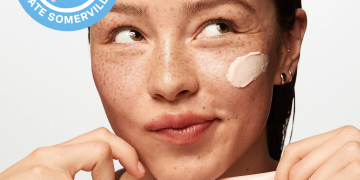The secret to a flawless makeup application lies in how you prepare your skin. Even the best cosmetics can only do so much if your skin isn’t properly prepped. A well-executed skincare routine ensures a smooth base, enhances the longevity of your makeup, and minimizes the appearance of imperfections. This guide will take you through a step-by-step process to get your skin ready for makeup, leaving you with a radiant, even canvas.
Why Prepping Your Skin Matters
Proper skin preparation has several benefits:
- Smooth Application: Makeup glides on effortlessly over a hydrated, exfoliated base.
- Improved Longevity: Prepped skin holds makeup longer, reducing the need for touch-ups.
- Enhanced Texture: Skincare helps minimize pores, fine lines, and uneven skin.
- Protection: A good prep routine creates a barrier between your skin and makeup, preventing clogged pores and irritation.
Step 1: Cleanse Your Skin
Cleansing is the foundation of any skincare routine. It removes dirt, oil, and leftover makeup, ensuring a fresh start for your application.
How to Cleanse:
- Use a gentle, sulfate-free cleanser tailored to your skin type. For example:
- Dry skin: Opt for a hydrating cream cleanser.
- Oily or acne-prone skin: Choose a gel cleanser with salicylic acid.
- Sensitive skin: Look for a fragrance-free, soothing formula.
- Rinse with lukewarm water to avoid stripping natural oils or causing irritation.
- Pat your skin dry with a clean towel, avoiding harsh rubbing.
Step 2: Exfoliate for Smoothness
Exfoliating removes dead skin cells, which can create uneven texture and cause foundation to cling to dry patches.
Exfoliation Tips:
- Chemical Exfoliants: Products with alpha hydroxy acids (AHAs) or beta hydroxy acids (BHAs) gently dissolve dead skin without scrubbing. These are ideal for sensitive skin.
- Physical Exfoliants: Use a mild scrub with fine particles, but avoid anything too abrasive.
- Frequency: Exfoliate 2-3 times per week, depending on your skin type. Over-exfoliation can lead to irritation.
Step 3: Hydrate and Balance with Toner
A toner helps to restore the skin’s natural pH balance after cleansing and exfoliating. It also adds a layer of hydration, allowing your skin to better absorb subsequent products.
How to Use:
- Choose a toner suited to your needs:
- Hydrating: Look for ingredients like hyaluronic acid and glycerin.
- Brightening: Opt for toners with niacinamide or vitamin C.
- Clarifying: Select toners with salicylic acid or tea tree oil for acne-prone skin.
- Apply with a cotton pad or your hands, gently patting the product onto your face.
Step 4: Apply a Lightweight Serum
Serums are concentrated treatments that target specific skin concerns, such as dullness, dryness, or uneven tone. They provide a boost of hydration and create a smooth base for makeup.
Recommended Serums:
- Hyaluronic Acid: Ideal for deep hydration and plumping.
- Vitamin C: Brightens skin and reduces dark spots.
- Niacinamide: Helps control oil production and minimizes pores.
Apply a few drops of serum and gently press it into your skin until fully absorbed.
Step 5: Lock in Moisture with a Cream
Moisturizing is essential to keep your skin hydrated and create a barrier that smooths texture. The right moisturizer prevents foundation from clinging to dry areas and enhances the overall finish of your makeup.
How to Choose a Moisturizer:
- Dry skin: Use a rich, cream-based moisturizer.
- Oily skin: Opt for a lightweight, gel-based formula.
- Combination skin: Focus on a balancing moisturizer that hydrates without adding excess oil.
Massage the moisturizer into your skin in upward motions, focusing on dry areas like the cheeks or around the nose.
Step 6: Prime Your Skin
Primer bridges the gap between skincare and makeup, creating a smooth canvas while addressing specific skin concerns. It also helps to prolong the wear of your makeup.
Types of Primers:
- Mattifying: Controls oil and minimizes shine for oily skin.
- Hydrating: Adds moisture for dry or dehydrated skin.
- Pore-Filling: Blurs imperfections and smooths texture.
- Color-Correcting: Neutralizes redness or sallowness with green or purple tones.
Apply a small amount of primer, focusing on areas where makeup tends to break down, such as the T-zone or cheeks.
Step 7: Protect with Sunscreen
If your makeup routine takes place during the day, sunscreen is a non-negotiable step. UV damage accelerates aging and can lead to hyperpigmentation, making sunscreen an essential part of any skincare routine.
Sunscreen Tips:
- Use a broad-spectrum sunscreen with at least SPF 30.
- Opt for lightweight, non-greasy formulas to avoid interfering with your makeup.
- Apply evenly to your face and neck, and allow it to fully absorb before proceeding to the next step.
Step 8: Address Specific Concerns
Before applying makeup, take a moment to address any specific concerns with targeted treatments or products. For example:
- Under-Eye Brightening: Use an eye cream to reduce puffiness and hydrate delicate under-eye skin.
- Spot Treatments: Apply acne patches or a salicylic acid treatment to blemishes to minimize their appearance under makeup.
Additional Tips for a Flawless Base
- Blot Excess Oil: If you have oily skin, gently blot your face with a tissue or oil-absorbing sheet before applying makeup.
- Use Clean Tools: Always apply makeup with clean brushes and sponges to avoid transferring bacteria or oils onto your freshly prepped skin.
- Avoid Overloading Products: Less is more. Applying too many layers can cause makeup to slide off or appear cakey.
The Result: A Radiant, Smooth Canvas
By following these steps, your skin will be primed and ready for makeup. Proper preparation not only enhances the look and longevity of your makeup but also promotes healthier skin in the long term. Whether you’re going for a natural glow or full glam, the right prep routine ensures that your makeup looks flawless every time.










